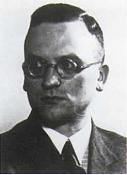Years of service 1933–1945 | Name Friedrich Panzinger Other work Lawyer Role Police officer Awards Iron Cross | |
 | ||
Rank Oberfuhrer (senior colonel) Service/branch | ||
Friedrich Panzinger (1 February 1903 – 8 August 1959) was a German SS officer during the Nazi era. He served as the head of Reichssicherheitshauptamt (RSHA) Amt IV A, from September 1943 to May 1944 and the commanding officer of Einsatzgruppe A in the Baltic States and Belarus. From 15 August 1944 forward, he was chief of RSHA Amt V, the Kriminalpolizei (Kripo; Criminal Police), also known as the Reichskriminalpolizeiamt (RKPA). After the war he was a member of the Bundesnachrichtendienst (BND; Federal Intelligence Service). He committed suicide after being arrested for war crimes.
Contents
Biography
Panzinger attended night school and began studying law. He took part in a recruitment test for the police and was admitted as a police officer in the civil service. As a police officer in Bavaria, Panzinger worked with Franz Josef Huber, and Josef Meisinger, both future Schutzstaffel (SS) officials. He finally completed a law degree in 1932. In the summer of 1933 Panzinger joined the Sturmabteilung (SA). He joined the Nazi Party with the number 1,017,341.
In April 1937, Panzinger joined the SS with member number 322,118. He was then employed as a Kriminalkommissar (Chief Inspector) in the state police headquarters in Berlin. On 29 June 1940 he began working in the Sicherheitspolizei (SiPo; Security Police) in Sofia, Bulgaria. In August 1940 he assumed the position of Secretary of Section IV A (Enemies) of the Gestapo, where he performed the task of fighting communism, Marxism and enemy propaganda within Nazi Germany until 4 September 1943. Panzinger's office consisted of the following subdivisions:
From 4 September 1943 to 6 May 1944 Panzinger succeeded Humbert Achamer-Pifrader as the commander of the three Einsatzkommandos of Einsatzgruppe A, which oversaw the Security Police matters in the area of Army Group North in the Baltic states and Belorussia as part of the Einsatzgruppen. Panzinger's unit carried out the killing of potential opponents and those deemed "racially inferior". During this time Panzinger was also Commander of the Security Police and Sicherheitsdienst (SD) in Riga. Panzinger was assigned to the headquarters of the SD and Gestapo in Ukraine.
A reorganization of Amt IV of the RSHA in March 1944 led to a breakdown of territory divisions between Panzinger and Achamer-Pifrader. While Panzinger took over leadership of sub-office IV A, he also served under Achamer-Pifrader in sub-office IV B. Panzinger's group now stood as follows:
In July 1944, after the 20 July plot to kill Hitler, Panzinger was appointed Chief of the Headquarters of the Gestapo, reporting directly to SS-Gruppenführer Heinrich Müller. Shortly thereafter, Panzinger was appointed Chief of RSHA Section V, the Kripo. He held that position until the end of the war. He succeeded Arthur Nebe, who was denounced and executed subsequent to the failed July assassination attempt on Hitler. He collaborated directly with Ernst Kaltenbrunner, the RSHA chief. Panzinger was responsible for the murder of prisoner of war French general Gustave Marie Maurice Mesny on 19 January 1945 near the village of Nossen.
Post-war and criminal charges
After the war Panzinger, considered a war criminal, was arrested in 1946 and imprisoned by the Soviet Union. In Moscow on 22 March 1952 he was twice sentenced to 25 years of forced labor. As a so-called Nichtamnestierter ("non-amnestied"), he was released in September 1955 and repatriated to Germany. He worked for a time on the staff of the Bundesnachrichtendienst (BND: Federal Intelligence Service) under Reinhard Gehlen and later, in 1959, he was employed by a trust company. In 1959, when charges were brought against Panzinger for the murder of Maurice Mesny, Panzinger committed suicide in his cell on 8 August 1959.
